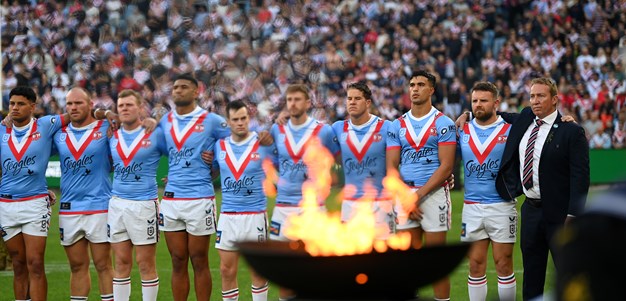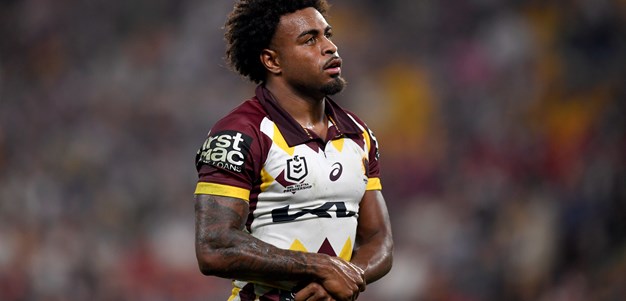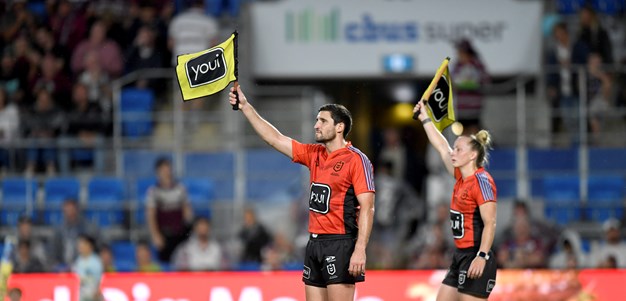Matthew Parrish is an assistant coach at the Parramatta Eels and also the New South Wales Blues.
This weekend in the NRL fans are bound to see more wonderful action from the game’s stars – highlights reel moments like Jarryd Hayne exploding through the middle of the ruck, or Billy Slater soaring high to defuse more dangerous bombs near his try line. But we’re likely to see more controversy too, as teams continue to struggle to conform to the new interpretation of the obstruction rule.
All NRL teams these days are using a second-man play behind a lead runner to try to penetrate well-structured defensive lines. This is now a bread-and-butter way of creating try-scoring opportunities – and clearly it has become the area in the modern game where obstructions are most prevalent.
Melbourne are the team that constructs this play better than most. The Storm have created many scoring opportunities compliments of the vision of Cooper Cronk and Slater. But it’s the work off the ball and the lines run by everyone else involved that leaves opposition defensive lines second-guessing.
Let’s look at what makes the Storm such a diverse attacking outfit. With Cooper Cronk as the ball player, throw into the mix a hard-charging back-rower such as Ryan Hoffman running a strong lead line, and also the elusive Slater sweeping out the back. What this trio does better than most is carry out their individual roles to perfection. And the plays are not always rehearsed; the players have the ability to adapt to the opportunities in the heat of play.
All three players are genuine options to break the line.
As a ball-player, Cronk will often take the ball right to the defensive line. Here he will turn square-on to the defence, looking to show-and-go himself should he feel his defender is starting to drift wider to take care of the potential threat from Hoffman, who is now charging hard.
Hoffman will hit the hole, on a perfectly run line, usually on the inside shoulder of the smaller defending half (generally located three men in from the sideline); if this defender starts to drift out because he is worried about Slater’s potential involvement sweeping around, Cronk will hit Hoffman with a short ball. Hoffman’s lines are always very genuine, therefore it is very difficult for the defending half to release his involvement and pick up the sweeping fullback.
And of course the third and most dangerous option is Slater, with his blistering pace slicing through even the smallest of holes: although he still has the skill-set to put on a short ball for his centre; a face ball to his winger; or even stab a well-placed kick into the in-goal behind the defensive line.
I would hate to see the tactic of using decoy runners disappear, despite the controversy surrounding the obstruction rule. It’s arguably the hottest topic in the game and something that needs addressing if we’re going to avoid arguments each and every week. Certainly there have been inconsistencies over the past few seasons, and I have no doubt that with the new interpretations, some coaches are instructing their players to go out of their way to make contact with the attacking player, or even take dives to avoid defending this play – something that’s not in the spirit of our game.
Make no mistake: I have no problem with the rule if the lead runner collides or obstructs a defender who is heading inside or out, or if the lead runner simply stops in the line and makes contact with a defender – that should be a penalty.
The problem I have boils down to intent. If there is a bad read by the defender coming outside-in to stop the hard-charging lead runner, then there is no way that the defending team should be rewarded with a penalty. This has been evident in the first three rounds.
Once the ball goes out the back to the sweep runner the onus is on the lead runner to avoid contact with the defensive line – but he can’t disappear! The disallowed try to St George Illawarra’s Brett Morris against the Raiders last week was a classic example of a perfectly executed play that went unrewarded simply because Morris’ teammate Ben Creagh made contact with Raiders defender Josh McCrone. Creagh had to go somewhere, and McCrone had absolutely no chance of stopping that try.
Then there was last week’s grand final rematch between the Storm and the Bulldogs, with Melbourne interchange Bryan Norrie’s contact on Canterbury prop Martin Taupau resulting in a ‘no try’ call on Cronk.
I don’t think anyone would disagree both of these plays would have been given the green light last season, and the coaches of both defending teams wouldn’t have had a complaint. So for them to be judged against the law in 2013? I’m not sure the new interpretations on obstruction are on the mark.
On another topic, it is great to see Ben Barba back and playing footy for the Bulldogs. He is a rare footballing talent and a genuine superstar of our game. I had the pleasure of working with Ben in this year’s Indigenous All Stars team with Laurie Daley and admired the way he carried himself throughout the busy week’s schedule off the field, and also marvelled at the skills he showed at training and on game day.
Obviously I was unaware of any problems he had away from footy, but it is testament of the man Ben that he can admit there is a problem, seek the appropriate help and then get back to what he does best.
Let’s hope Josh Dugan does the same.
Our game needs two great young players like them happy and playing football.



